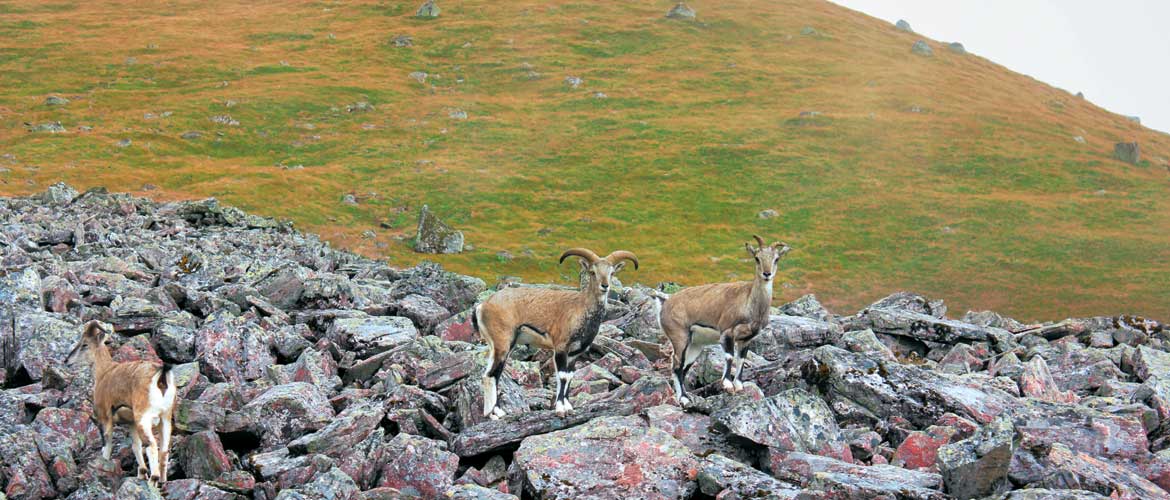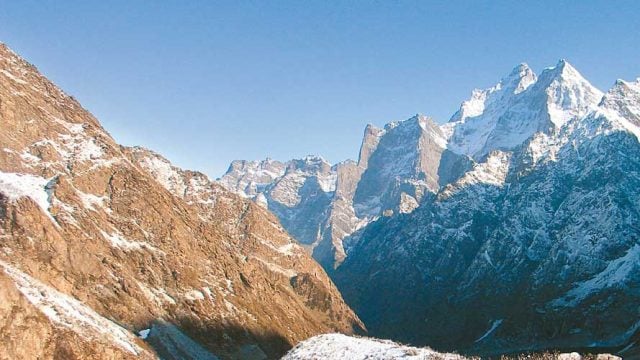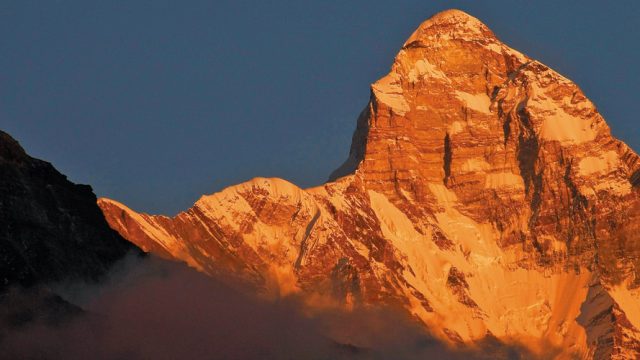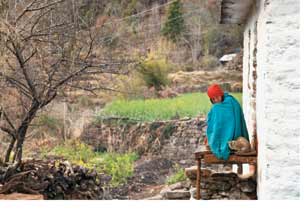Nanda Devi doesn’t seem to be happy with us,” said Munia, my 10-year-old daughter, who
Suraithota, the base camp from where we were supposed to begin our short trek to Tolma village, was still 8km away. As the rains stopped, we crossed the stretch on foot and spent the night at a forest chowki in Rainee. Luckily, the next day dawned sunny and the views became clearer. However, the weather was quite cold and windy.

At a distance, we spotted a herd of Himalayan tahrs hopping down the cliffs. Further ahead, near Lata village, we saw a lammergeier nest. Himalayan griffons soared overhead.
After a jeep ride to Suraithota, we walked up to Tolma. The striking Dunagiri peak towers above this 10-house village. Despite my daugh-ter’s worries, we had finally reached this beautiful land.
About Nanda Devi NP
Nanda Devi (7,817m) is the second highest in India. For a long time, its inaccessibility gave it the aura of a forbidden territory. The first explorers of the inner sanctuary were Eric Shipton and Bill Tilman, who discovered a route to the Upper Rishi Ganga Gorge in 1934. Two years later, Tilman and Noel Odell made the first ascent of Nanda Devi. By the early 60s and 70s,the sanctuary had become so popular with trekkers that more than 4,000 people were entering the park annually. Shepherds and residents of neighbouring villages were also frequent visitors. Alarmed by the piling garbage and ecological damage, the government banned the entry of people in the sanctuary and declared it a national park in 1982. In 2004, the government partially opened the park to trekkers, who were permitted to go up to the meadows of Dharansi and Debrugheta. It was declared a World Heritage Site in 1988.
ORIENTATION
The National Park is encircled by a spectacular range of mountains, such as Trishul (7,120m), Dunagiri (7,066m) and Changabang (6,864m). Lata and Tolma villages are the two entry points to the Nanda Devi National Park. However, the climb from Tolma is much easier than from Lata.
THINGS TO SEE & DO
Trekking

Dharansi and Debrugheta are located to the northwest of the park. The former is the last point for camping. To enter the park, you have to first get a permit from the Divisional Forest Officer at Joshimath.
For treks up to Dharanasi, there is a one-time eco-tourism fee for seven days: ₹60 per person). There’s a fee of Rs. 20 per day, per person for porters or guides that you hire. Only groups of five persons per day, excluding accompanying staff, are allowed into the park.
All provisions including kerosene must be carried, and non-bio-degradable materials have to be brought back. Renting a tent will cost you ₹100 per night.
There are about 10 trek operators approved by the forest department. To visit the park, you have to book with one of them. Eskimo Adventures (ask for Dinesh Uniyal on 01389-222630, 222864, Cell: 0975-6835647) is a reliable option. You can also try Mountain Shepherds.
WHERE TO STAY AND EAT
Homestays are run by Mountain Shepherds (Cell: 09719316777, 09761188401; Tariff: ₹1,500, with meals; W mountainshepherds.com). Those in Lata and Tolma villages (Tariff: ₹2,000, with meals) are the best.
Mountain Shepherds is an offshoot of the Nanda Devi Campaign that had begun for cultural survival and livelihoods. It had been spearheaded by the Marcha Bhotia community of this valley.
As part of homestays, you get to stay in small but very comfortable traditional village homes, and enjoy delicious local cuisine.
AROUND NANDA DEVI NP

Rainee
This village was the launch pad of the Chipko Movement. On 25 March, 1974, Gaura Devi led the women of her village against timber contractors by hugging the trees that had been marked out to be cut.
Lata
The most well-known village around the park, it houses Nanda Devi’s idol in an ancient, beautiful temple.
Nanda Devi Yatra
Named after the most beloved goddess of Uttarakhand, Parvati, the Nanda Devi peak is surrounded by a ring of 12 high mountains, and shrines dedicated to her are scattered all across the Central Himalayan range. While Goddess Parvati is believed to reside on the Nanda Devi peak, the Trishul peak (a trident-shaped hilltop) next to it, is considered to be Lord Shankar’s abode. The rims of the peaks are believed to surround the goddess’ bed (Nanda khat), her veil (Nanda Ghungit) and her kitchen (Nanda Kot). The clouds floating around the Nanda Kot are often ascribed to the smoke coming out of the goddess’ kitchen.
The Nanda Devi Jat is celebrated annually in the temples of Nanda Devi across Garhwal and Kumaon. The festivities commence with the devi’s visit to her maiti (parents’ home) and culminate with her return to her husband’s home. This tradition is beautifully portrayed in the folk songs sung by women.
An annual yatra (pilgrimage), called the Chhoti (small) Jat Yatra, is celebrated around end-August or early-September. It starts from Wan and ends at Bedni Bugyal.
Once in 12 years, this festival is transformed into a magnificent 21-day journey guided by a four-horned ram which leads devotees to Shiva’s home at the base of Trishul. This is the Nanda Devi Raj Jat Yatra.
GETTING THERE
Air The nearest airport is Jolly Grant (270km/ 9hrs) at Dehradun. A taxi costs approximately ₹6,000
Rail The nearest railway station is Haridwar (300km/ 10hrs). A taxi costs approximately ₹6,500
Road Take NH58 from Delhi to Joshimath (492km/ 15hrs). En route, you can halt at Haridwar and Rudraprayag. From Joshimath, it takes 1.5hrs to cover the 25km to the roadhead for Lata village. Lata is 2km ahead. Suraithota, another base point for the trek, is 6km ahead of Lata
FAST FACTS
When to go Summer is the ideal time to trek or walk around the park. If you can brave the cold, October and November are best for spotting wildlife
Tourist offices
DFO
Nanda Devi National Park
Joshimath
Tel: 01389-222179
GMVN
102, Indraprakash Building
21, Barakhamba Road
New Delhi. Tel: 011-23350481
W gmvnl.com
STD code 01389
State Uttarakhand
Location In Chamoli District in the Great Himalayan range, irrigated by the Dhauli Ganga and Rishi Ganga rivers
Distance 320km N of Haridwar, 519km NE of Delhi
Route from Delhi NH58 to Joshimath via Meerut, Muzaffarnagar, Roorkee, Haridwar, Rishikesh, Devprayag, Rudraprayag, Karnaprayag, Nandprayag and Chamoli; state road to Lata village, on the periphery of the park
North Zone
OT Getaway Guides
Wildlife Holidays in India





